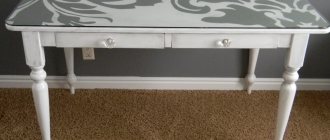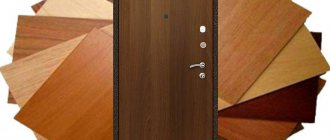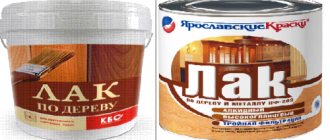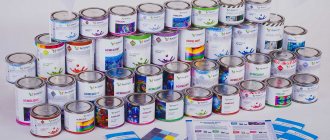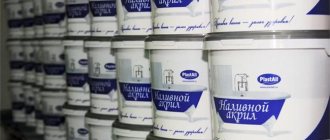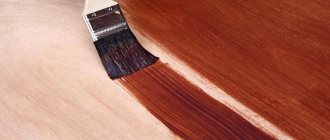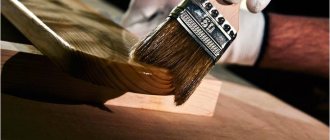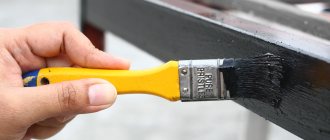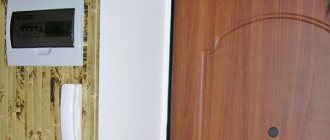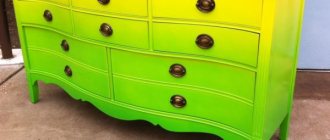How to paint a wooden street door: choosing paint
The ecology of your home will be at risk if the wood paint you choose contains petroleum products. The most toxic of them are toluene and xylene. These aromatic hydrocarbons should not be present in the paint. Therefore, carefully study the composition of the paint on the packaging.
- Nitroenamel is a nitro paint on wood that emits a suffocating odor. This paint is applied quite easily with a brush and dries quickly, in just one hour. But to be completely honest, such a coating is not very functional. When applying nitro enamel, the solvent evaporates. The result is a coating that practically does not stick to anything: neither acetone nor water. Plus poor stain resistance.
- Alkyd enamels are traditionally popular among consumers. They are superior to all organic solvent based paints in terms of abrasion and durability. By carefully preparing the coating surface and following the paint application technology, you can achieve excellent results: a beautiful glossy surface. However, alkyd enamels also have disadvantages. They can be called paints for those who are patient: they dry from 12 to 24 hours.
- Acrylic water-dispersion paints are water emulsions, one of the most optimal options for painting wood. They dry well and have no smell. They are easily applied to the surface, have good adhesion and form a perfectly even coating. Acrylic paints are durable and resistant: filling the smallest cracks they can form a durable surface.
If you want to live in an environmentally friendly home, choose paints that contain foundationicides and biocides. These are environmentally friendly compounds that can protect wooden surfaces from mold and fungi.
Preparing the door surface
At the first stage, the old facing material is removed
This process has several stages. At the first stage, the old facing material is removed. This includes layers of paint, primer and putty. All this must be completely removed down to the wooden surface. Here it is ideal to use a high-quality hair dryer and then remove the material with a spatula. An alternative to such equipment is sandpaper or a grinder. In addition, you can use special wood removers.
Next, the surface of the wooden door must be carefully sanded and all kinds of defects on it must be eliminated. This includes cracks, scratches, dents and the like. At this stage, craftsmen often use sandpaper or a sander attached to a vacuum cleaner. This process must be performed with special care. Before proceeding with the next work, the surface of the door is carefully inspected to ensure quality.
Large imperfections are easier to completely cover up. If you plan to cover the door with varnish, oil or stain, the putty should be specialized for wood. In the case when opaque enamel is used, the color of the putty does not matter.
The packaging with putty indicates its drying time. It must be maintained, and only then the grinding process can be started a second time. Regular sandpaper is quite suitable for this. Deep dents can be easily repaired with putty that does not contain fiberglass.
Classification of paints and varnishes
The exceptional variety of assortment and the widest range of color solutions for paint and varnish products presented on the shelves of modern stores are able to satisfy the needs of the most demanding customer and allow the most extraordinary design projects to be realized. All paint and varnish materials, including those used for painting doors, can be classified as follows:
- by type: impregnations (stains, etc.), varnishes, paints (enamels);
- by chemical composition: water-soluble or based on organic solvents;
- by area of application: for interior work, for exterior work, universal;
- by the nature of protection: from changes in humidity and temperature, from mechanical, chemical and other influences.
Various shades of tinted varnish allow you to create an imitation of valuable wood on a wooden surface.
In addition, coatings formed with these materials can be transparent or opaque. Transparent coatings form varnishes, glazes and oil impregnations (including drying oil). Various types of paints and enamels are opaque:
- oil;
- alkyd;
- polyurethane;
- acrylic;
- perchlorovinyl.
Each of the above types of paints and varnishes has a number of specific characteristics that ultimately determine their scope of application.
An important role in the process of painting a door is also played by special priming compounds (primers), which make it possible to create the most even, strong and durable coating.
Varnishing of doors
It is advisable to use various kinds of transparent and translucent varnishes to coat doors made from solid natural wood and veneered doors.
Transparent varnish allows you to preserve the texture of wood and even highlight it favorably. This property is especially valuable when processing doors made of valuable wood. Of course, a door prepared for coating with clear varnish should not have any defects that would spoil the appearance of the product. Translucent (tinted) varnishes are available in a wide variety of colors and shades, allowing you to imitate one or another valuable species when applied.
Most often, 2 main types of varnishes are used:
- nitrocellulose (NC);
- pentaphthalic (PF).
A distinctive feature of nitro varnishes is the high drying speed of each layer, which forms a durable film with a low gloss. However, nitro varnishes are quite toxic, which is why they have a limited scope of application.
Pentaphthalic varnishes are much less toxic, but they also take much longer to dry (at least a day). When dry, PF varnishes form a durable coating with a pronounced shine.
Regardless of the type of varnish chosen, the final quality and degree of gloss of the coating will directly depend on the number of layers applied.
Painting doors with enamels and paints
Acrylic washable interior paint is very resistant to abrasion and does not have a characteristic specific odor.
How to paint wood
In the modern building materials market there is a large selection of coloring compositions
In the modern building materials market there is a large selection of coloring compositions. The choice in favor of one or another substance is determined by your desire to preserve the natural beauty of the tree or make its appearance more original and unusual. There are several types of dyes:
- opaque enamel;
- acrylic, polyurethane, perchlorovinyl and oil paints;
- varnishes, tinted or transparent;
- stains and oil impregnations.
The latter are perfect for creating an original interior. They can refresh the color of a wood surface or give it a number of new shades. Experts in the field of construction and cladding recommend that beginning craftsmen give preference to water-based acrylic paints. Such substances are very convenient to work with a brush; they have excellent consistency and excellent spreadability. The ability to evenly cover the surface being treated is somewhat worse than that of oil paints.
Also, alkyd paints and varnishes are suitable for painting wooden doors. These substances have water-repellent properties, are resistant to frequent temperature changes and dry fairly quickly.
Alkyd paints can be used to paint both interior and exterior doors. They are also used to paint bath doors, thanks to the qualities described above.
If you choose these particular substances, you must take into account that they only paint completely dry surfaces. Otherwise, the layers of paint will very quickly become covered with cracks and many bubbles will form underneath them. In this case, the aesthetic appearance of the door will deteriorate significantly.
Selection of painting material
High-quality paint does not come cheap. Sometimes stores offer discounts on quality paints as they approach their expiration date. If painting is carried out immediately after purchasing the paint and varnish material, then this option will save money without reducing quality.
When thinking about what solid wood doors are coated with, you will need knowledge about paint and varnish materials. The range of paints is divided into: transparent, opaque. The first include impregnations, varnishes, and glazes. When the canvas is treated with a transparent coating, the natural color and wood pattern are emphasized. For solid wood canvases, varnish is often used. It protects the surface from moisture and various influences. Varnishes come in clear and tinted varieties.
Important. When purchasing varnish, pay attention to the drying speed. It is better to take quick-drying paintwork. It does not spread on the surface and is also harmless.
Opaque coatings include alkyd and oil-based coloring materials that have their own characteristics. Most often used:
Paint for doorways
- Nitro paint. It has aesthetic properties, a wide color palette that is superior to other types of paints. It has strength and wear resistance. But it is harmful to health, its fumes are toxic.
- Acrylic. Suitable for use in rooms. When painting, it applies well and there is no toxic smell. The disadvantages of paint include low strength and high cost. To increase durability, acrylic varnish is applied to the paint.
- Alkyd enamel. It is affordable, has a wide range of shades, and forms a durable coating. This paint is suitable for wooden doors, it is wear-resistant, economical, and dries quickly. Significant disadvantage: the unpleasant odor persists for 2 days. This type of paint is not used where allergy sufferers or children live.
Types of paints
In a specialized store you can find many different paints and varnishes. As a rule, buyers focus on color when choosing, but there are other characteristics that must be taken into account. Only in this case will you get the expected result.
When choosing what to paint interior wooden doors with, you should find out about the accepted classification:
- depending on the composition, paints are organic or water-based;
- according to the method of use they are divided into combined, external, internal;
- depending on the protective effect, the products can withstand chemicals, temperature fluctuations, humidity, and mechanical stress;
- depending on the type - impregnations, stains, paints, varnishes.
Painting a wooden door
At this stage, all preparatory work is completely completed. Now let's figure out what is the best way to paint a wooden door. We will also look at the tools and methods of applying enamel or varnish to a wooden surface.
Selection of paints and varnishes
In fact, the choice is not as wide as it might seem at first. The chemical industry offers the following types of paint to choose from: oil paint, alkyd enamel, acrylic enamel and nitro paint.
Of course, everyone knows that stains and clear varnishes are great for painting wood, but in this article we are omitting them due to the fact that it is almost impossible to remove the old paint 100%, and no one wants it to show through the new topcoat . That is, to paint an old door we need opaque paint.
- The most common and affordable enamel is alkyd. It has good coating strength, has a glossy surface, and also has a wide range of colors and shades. The main disadvantage is the persistent chemical smell. The alkyd aura hovers in the air for at least two days, which creates inconvenience when using such paint in residential premises.
- The absolute opposite is acrylic enamel. It has a low-strength surface and practically no smell, has a wide selection of colors and a matte finish. Due to its low strength, it requires the application of a top layer of special acrylic varnish, which leads to additional financial costs. By the way, the price of the paint itself is much higher than its alkyd counterpart, which can also be considered a disadvantage.
- Modern oil paints, in their properties, are almost identical to alkyd enamels, and differ in that natural drying oil is used in their production. They can be tinted in any color, and the coating is durable enough for several seasons, even in very humid conditions. An additional disadvantage is the long drying time of the coating.
- Nitroenamel and nitrovarnish are the most durable coatings for wood. The applied layer has a durable surface and a noble appearance. Moreover, such material is the most toxic of this trinity, and requires careful handling, especially in conditions of poor ventilation.
Sequence of the painting process
Since the list of components of the door structure includes not only the door leaf, the stage preceding the entire action is the competent preparation of the object. You can, of course, limit yourself to painting only the canvas, but then the jambs with the lintel will be different. This means that home craftsmen who decide to paint the doors with their own hands need to do this:
- remove the door leaf from the hinges and place it on two stools, a work table or sawhorses. If you plan to use a caustic alkyd composition, it is advisable to place it in the yard, on the terrace or balcony;
- Without removing the panel, block it with wedges so that the panel brush has access to all door elements. Locking is also necessary so that the door does not accidentally close during the drying period, and the dye layer is not irreparably damaged.
It is recommended to remove the canvas, but if it is impossible to do according to the rules, then we will use the second option. The fittings also need to be dismantled. In a hopeless case with non-removable hinges, handles should be wrapped in paper and secured with tape, but it is better to wrap them in foil so that all parts are tightly sealed. It is better to fix the lock mechanisms and seal them with tape.
Preparing the wooden surface
The most significant multi-step process that requires diligence in order for coloring to give the desired result. We will prepare according to the following standard scheme:
- First, we remove all layers of paint, primer and putty materials down to the wood. For those who are not afraid of dust and dirt, you can use a grinding machine or a homemade device made from a handy block with medium-grain sandpaper glued or nailed to the working side. It’s easier for owners of construction hair dryers; they heat it up and remove the bubbled paint with a spatula. There is also a simple, but expensive method - special wood removers.
- Then we undergo initial sanding, as a result of which small dents, paint residues and scratches are eliminated. We sand with a machine connected to a vacuum cleaner, or simply with medium-grain sandpaper.
- We putty large imperfections by purchasing a putty that matches the wood if we plan to cover the door with a transparent composition: oil, stain, varnish. If we paint with opaque enamel, it is not necessary to select the color of the putty. Don't forget about the gaps between the decorative elements of the canvas and the canvas itself, between the jamb and the lintel.
- We maintained the period indicated by the putty manufacturer in the manual and sanded it a second time with sandpaper. First, we use a machine attachment or a simple abrasive cloth with medium grain, and at the finish we use a fine-grained analogue.
Advice. Deep dents under opaque paint can be repaired with auto putty, which does not contain fiberglass.
Note. Natural wood that has darkened under a layer of old paint or varnish can be lightly bleached with a mixture of one part bleach and bleach with three parts water.
Everything was processed, cleaned of old varnish or paint, and any putty that had come out. We vacuum, wipe with a damp cloth, dry, and start painting.
Painting a door without special effects
That is, at the beginning of the creative path of a future phenomenal painter and cabinetmaker, we will not get carried away with artificial aging. We will not create the impression of photo wallpaper or a painted array with uncovered structural lines. At the initial stage, we will learn how to paint the door evenly without frozen smudges or spots visible under the varnish.
This video will demonstrate how to paint using a sprayer:
If you only have to paint one or two doors, purchasing a sprayer is not cost-effective. We will stock up on a narrow panel brush for a canvas with the same name and a roller for all types of canvas.
Note. Before starting the work process, the brush needs to be fluffed up; all loose hairs need to be helped to come out and be removed.
Let's decide on the type of construction and the painting scheme that depends on it:
- The panel door is painted in three steps. It is more practical to use a roller; it will ensure uniformity and will not leave hairs. Let's start covering from the end, more precisely from the upper left corner of the canvas, directing movements to the right side. We paint the canvas until the very end, and dry it for as many hours as the manufacturer requires. The second step of coloring is carried out in the longitudinal direction, and the third in the opposite direction to the initial stage.
- Let's start painting the paneled door with a brush. We will use it to go through the recesses in the canvas, trying to avoid an excess of paint. We complete the painting with a roller, following the steps listed above.
What to do if you decide to paint with stain?
The door prepared for painting needs to be slightly moistened, then the wood will not absorb moisture and the dye will lie smoothly with a very liquid consistency. We will paint everything that is located horizontally with stain first along the fibers, then in the transverse direction, and at the finish again longitudinally.
We will begin to cover the jambs and the canvas that has not been removed from the hinges from below, so that drops and splashes of dye do not fall on unpainted areas. This is what we do if we open the door with varnish. If the finishing composition is opaque, dark drops will not interfere at all.
After treatment with water-soluble stain, the wood fibers that have absorbed moisture are straightened. You will need to sand them with sandpaper after the first layer has dried. Then we will clean it from dust and cover it again.
Note. The wooden surface that has dried after painting is lighter than when the dye was applied. The richness of color is achieved by repeated opening.
Alcohol stain will not stimulate fiber straightening. There is no need to sand the door after treating it and it dries in half an hour. However, its water-soluble counterpart is considered a safer, completely non-toxic dye, and therefore more popular.
Features of applying stain and varnish
Any wood is suitable for coating with stain: pine, oak, birch. It should be applied generously so that the surface is saturated. After the wood has absorbed the stain, you need to remove the residue. For washing, use a brush and acetone. It is necessary to carry out this procedure until the composition stops being washed off. After this, the door should dry well.
Varnishing is carried out in two stages. After the first layer has been applied, you need to wait for it to dry and remove any roughness and unevenness with sandpaper. After this, it will be necessary to varnish the coating again.
Painting veneered fabric
If your interior doors are made of veneer, then the sanding procedure should be carried out with extreme caution. It is unacceptable to use grinding machines - they can damage the top layer of veneer. The work must be done manually, and it is better to entrust this task to professionals.
It is necessary to carefully select the coating material:
- If the door is completely new and you are simply not satisfied with its color, then you can do without sanding. Just choose the varnish of the desired shade and get to work. If there are small defects, you can simply varnish them and then rub them with polish.
- Doors made of artificial veneer are suitable for painting. But there are some difficulties associated with the fact that such a door has a smooth surface from which paint will roll off. You can use a primer, but in this case the effect of the natural wood structure will not be preserved.
In this case, the paint must be applied in two layers. To paint a veneer door, you should choose water-based paints. If the paint structure is dense, the individual coating pattern will be lost.
Before processing a veneer door, carefully consider and evaluate the scope of the upcoming work. If there is a small flaw in the form of a scratch, you can get by with local painting. If you need to radically change the color, carefully choose the coating. If you change the surface of the outer layer with chemical dyes, the environmental friendliness will be compromised.
If you follow the suggested tips and recommendations, updated interior doors made of solid pine or other wood will become your pride and will enliven the interior of your apartment.
Recommendations for choosing colors
The color of interior doors should be in harmony with the rest of the interior. There are several recommendations that will help you maintain the overall stylistic decision:
- If the room contains lacquered furniture in dark tones, then it is advisable to choose a door coated with dark impregnation or stain. To protect against external influences and add gloss, such canvases are often covered with colorless varnish.
- It is recommended to paint the bedroom door in colors that match the color of the bedroom set. Furniture with white or pastel shades will go well with surfaces of the same calm colors (white, cream, beige, etc.).
- Massive vintage antique furniture will look more advantageous when paired with door leaves made using the artificial aging technique.
- In a house made of timber, doors made of natural wood, treated with oil-based impregnation, are appropriate.
- Canvases in dark, rich colors (red walnut, chocolate, etc.) look good in the living room, as they add sophistication to the room.
By following all the tips and recommendations, you will be able to easily and quickly paint doors made of natural wood with your own hands, without turning to cabinet makers for help. No special skills or abilities are required to perform this work. If everything is done carefully and competently, the result will exceed expectations.
Scheme, procedure for coating a door with paintwork
The painting material is applied to the doors according to a specific pattern. The panel surface is painted in 3 stages. It is better to use a roller. It ensures uniform application and does not leave streaks. Start painting from the top from the corner of the door, across from left to right. Then, after drying, apply a second layer lengthwise, and a third layer crosswise.
The paneled door is painted with a brush, starting from the recesses. Make sure that no excess paint remains. Afterwards, the door is painted with a roller in accordance with the painting scheme for the panel surface. For rich color, paint in 3 layers.
Before varnishing doors, take into account the number of layers. Quality and appearance depend on this. Most often apply 3 times. Each layer is applied after the previous one has dried. The number of layers can be found on the varnish jar itself - information is provided by the manufacturer.
The varnish is applied to the wooden door with a large brush. If there are patterns, then use brushes of different sizes. To ensure that the varnished surface is smooth, painting is carried out on a flat surface with the door in a horizontal position.
To varnish, the canvas is placed in a horizontal position.
The first (base) layer is made with diluted (water, solvent) varnish along the length of the wood structure. You cannot stop the process, as dark spots remain. The next layer is applied crosswise, after drying and treating the surface with fine sandpaper. Varnishing of wooden doors is carried out until a smooth surface is formed.
Attention! If a drop of varnish gets on the surface and has time to dry, it is better to leave it as is. Otherwise, you can ruin the appearance.
Types of LKS
Transparent
The expediency of their use follows from the definition: such compositions reliably protect the base without hiding its texture. For example, for doors in wooden buildings (log buildings) it is the optimal choice. This group of LCS includes various varnishes (colorless and with tinting components), impregnating compositions (including complex ones), and glazes.
Opaque
In everyday life, it is precisely such LKS that are usually called paints. It is worth noting that not all of them are suitable for use at home, and therefore when choosing a composition you need to carefully read the instructions and recommendations of the manufacturer!
- Oily. The cheapest paints, which are gradually losing their popularity. They reliably protect wood from external factors and are sold in a large assortment. But painting wooden doors with your own hands with such a composition is inconvenient in the sense that you will have to wait a long time for it to completely dry.
- Acrylic. They are based on water, and therefore these paints are most often used for painting wood. Advantages: rapid hardening of the layer, its elasticity, good fluidity of the composition, absence of harmful components.
Paints of this group are not wear-resistant. To keep them on the wood longer, it is advisable to apply another layer on top - cover with a special acrylic varnish.
- Nitro enamels. They are characterized by a large color palette (up to 15,000 different shades). With their help, the problem of how best to repaint a door is quickly solved. If you add a plus such as increased wear resistance, then this is one of the acceptable options. But there is a negative point - toxic fumes. During work, it is necessary to organize effective ventilation of the room. In some cases, it is recommended to use a respirator.
- Alkyd paints. Painting interior doors with compounds of this group provides many advantages - durability of the protective layer, a large selection of shades, low cost of decoration. But the downside is that the sharp, unpleasant smell lingers in the room for quite a long time. In this regard, alkyd paints are identical to nitro enamels. Moreover, under certain conditions, harmful substances continue to be released into the environment even after the composition has hardened. When deciding which paint is best to paint wood, you need to understand that the use of these LKS for updating interior doors in bedrooms and children's rooms is not recommended.
Preparing the door leaf for painting
Before you start painting, you need to prepare the door leaf. Preparation includes several stages:
- Remove the door from its hinges. This will make it more convenient to carry out all the necessary work.
- It is advisable to remove the lock and handle so as not to smear it with paint.
- Remove old paint defects or all paint. If the old paintwork is in good condition, then the entire layer does not need to be completely removed. Only places where there are obvious defects. If you need to remove the layer completely, you will need a hair dryer or a special paint remover.
- Wash the door from dirt and dust.
- Degrease the surface with solvent.
- If there are flaws on the surface: cracks, potholes, they need to be puttied.
- Degrease and prime the surface again.
- Allow the primed canvas to dry and repeat again.
The preparatory stage has been completed. You can start painting the canvas.
Dyeing technology
The dyeing technology may vary depending on:
- the material from which the canvas is made;
- type of paint coating.
It is necessary to take into account the features of all materials and follow step-by-step instructions.
If you want to paint a veneer door, use varnish, stain or acrylic enamels. In order to maintain the environmental friendliness of the design.
Painting an MDF door
Features of painting MDF canvas:
- The surface must be made glossy. Therefore, it is necessary to select appropriate paint and varnish materials.
- To increase adhesion, the surface must first be primed.
- MDF surfaces absorb paint strongly, so it is better to choose quick-drying compounds.
- If the sashes are blind, then use a paint roller. This way you will save time, paint and get rid of fluff that falls out of the brush.
- The more drying oil you use to prime the door, the more uniform the surface will look after painting.
Preparatory work before painting
To cover the door with paint and varnish, you need to carry out some preparatory work. First of all, prepare the tool:
- brush;
- paint container;
- rags;
- gloves;
- scotch;
- sandpaper;
- 4 stools;
- putty knife.
Be sure to prepare paint and varnish materials.
Painting tools
The next step is preparing the canvas. It is removed from the canopies and placed horizontally on stools. If the chosen paint has a pungent, unpleasant odor, then the work should be done outside. Remove the fittings. Fixed elements are wrapped in paper and tape. The lock is closed with masking tape. To properly coat the surface, prepare it:
Removing old coating
- Remove the old paint coating and primer using a grinding machine, sandpaper, or stripping solution.
- Pre-grinding is performed, which helps remove scratches and paint.
- Remove dust and dirt.
- Fill imperfections and cracks in wood.
- After drying, the canvas is puttied with medium-grain sandpaper and then with fine-grain sandpaper.
Attention. Darkened wood is lightened with a mixture of chlorine bleach and water (3 to 1).
